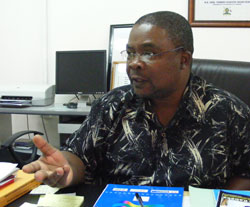
By Patrick Kagenda
On August 18 a Tanzanian cargo vessel MV Azza sunk on Lake Victoria with 200 tones of mineral water, 40 tones of cotton seed cake belonging to Century Bottling Co., the manufacturers of Coca cola. Azza was privately owned but its sinking added to the challenge of getting Ugandan cargo on Victoria from Tanzania. The independent’s Patrick Kagenda interviewed Uganda’s state minister for transport John Byabagambi about the Uganda government’s plans on the so-called ‘Southern Route’.
Independent: A Tanzanian registered vessel recently sank with Ugandan destined cargo, what does this mean to Uganda as a country?
Byabagambi:It is very sad that such a scenario occurred and secondly it means Ugandan destined cargo via Lake Victoria may be no more.
You see this was a privately owned vessel and according to information availed to me, it is said to have been a very old vessel and was overloaded. Secondly I don’t think it met the required marine standards; its navigational equipment and servicing. The little I can tell you is that the ship was not well maintained and could have developed holes in the buoyancy tanks because of its age and ended up sucking in water due to overloading and had to sink.
How does a marine vessel run without navigational equipment?
Marine vessel captains use instinct and experience on the route to navigate their vessels through. Besides there are beacons they follow and they will always be right on course even without a radar.
Around April you promised Uganda that Mv Pamba would be on the water running. What has happened since that time?
The whole issue was complicated by PPDA (Public Procurement and Disposal of Public Assets Authority). Otherwise we still have the money for repairing MV Pamba on account.
How did PPDA complicate the issue?
Those people do their things with a lot of bureaucracy. I would have loved to see the ship on the lake yesterday, but I can’t because I am not the final person, we have to wait and follow procedure.
What about the new ship you had said government was going to buy?
That will come, but after a lengthy period. Our priority right now is to see the central corridor which you people call southern route up and functioning very well. I think PPDA has got a consultant for the renovation of the wagon ferries and we have formed what we call the Central Corridor Transit Route organization headquartered in Dar-es-Saalam to oversee the maintenance and upgrading of the road network all the way from Kampala up to the port of Dar-es-Saalam.
How much does a new wagon ferry the size of MV Kawa cost?
It is between $ 25-30 million (shs 40 billion-48 billion), assuming the dollar is at shs 1,600.
So why not finish one thing at ago?
We have enough resources for both. In the 2008/9 budget roads and infrastructure were given big money for this very reason. We don’t want a repeat of early this year when political turmoil in Kenya almost ground us to a halt.
How soon should we expect to see the marine vessels on the water again?
As soon as PPDA finalizes with its work of tendering for the renovations, because what we are going to do is just change the engines and some minor repairs here and there and they will be back on the water. Those ships still have a long time to serve. They are about thirty years old. A ship can serve for over seventy years as long as it is serviced. Its like an aeroplane, when its air worthiness hours are over it has to be overhauled, so is the ship.
Have you received any applications from the private sector to operate marine vessels?
There are so many private investors willing to come in but the problem is the landing infrastructure. We need to improve upon it. We need cranes, to load and offload cargo. The ministry of works and transport is considering development of the landing infrastructure. Our first option is to improve the marine infrastructure before we attract private operators.
 The Independent Uganda: You get the Truth we Pay the Price
The Independent Uganda: You get the Truth we Pay the Price



